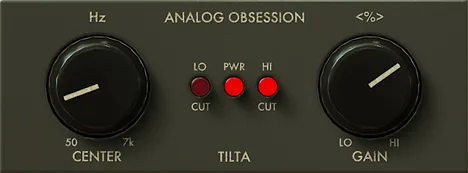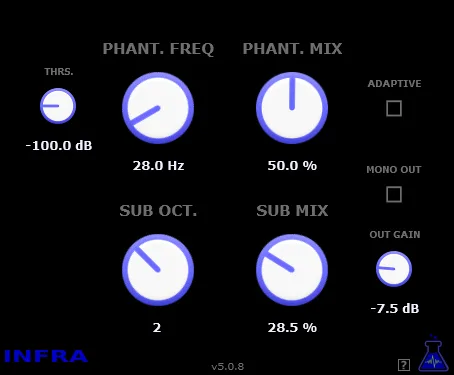TILTA by Analog Obsession: The Art of Tonal Balance with Simplicity
In the world of modern music production, the ability to quickly and effectively shape the overall tone of a mix is extremely valuable. While detailed equalization of individual instruments remains foundational, sometimes you need a tool for broad, musical corrections – something that can change the overall feel of a track with a single movement. It is for such tasks that TILTA by Analog Obsession was developed.
TILTA is not just another equalizer. It is the embodiment of the classic “tilt equalizer” concept in a modern digital format. The idea of a tilt EQ is to create a tilt in the frequency response, simultaneously boosting or attenuating a whole range of frequencies from a chosen fulcrum. Think of it as a seesaw: when one side goes up (e.g., high frequencies), the other goes down (low frequencies), and vice versa, with the center of rotation at a selected frequency. This approach is extremely effective for quick tonal balance adjustments, adding warmth, “air,” or clarity while maintaining a natural sound.
Analog Obsession is known for its attention to detail and ability to create plugins that not only sound great but also have an intuitive interface. TILTA is no exception. Its simple design hides powerful functionality, allowing you to quickly integrate it into any workflow.
Deeper Dive into TILTA’s Controls
TILTA’s simplicity is evident in its minimalist set of controls, each of which has a significant impact on the final sound. Understanding their interaction is key to achieving the desired result.
- CENTER: This control, which covers a range from 50 Hz to 7 kHz, determines the “fulcrum” for the tonal tilt. Frequencies below this point will move in the opposite direction from frequencies above. For example, if you choose a low center frequency and boost the GAIN, you’re adding weight in the very low range, slightly attenuating everything else. Selecting a higher center frequency will allow you to focus the tilt on the mid and high frequencies. Experimenting with this parameter is important to find the perfect balance.
- GAIN: The GAIN control, offering a range of +/- 10 dB, sets the degree of “tilt.” A positive GAIN value boosts frequencies above the CENTER and attenuates frequencies below, making the sound brighter and more transparent. A negative GAIN value, conversely, boosts frequencies below the CENTER and attenuates frequencies above, adding warmth, density, and “body” to the sound. Even small GAIN changes drastically alter the overall character of the sound.
- LO CUT & HI CUT: These cut filters are critical for shaping a clean and focused sound. LO CUT allows you to get rid of unwanted low-frequency “garbage” – hum or excess sub-bass, which can make the mix muddy. HI CUT performs a similar function in the upper range, helping to tame excessive harshness or noise. Using LO CUT and HI CUT together with the tilt function allows you to create a more controlled tonal contour.
TILTA in Your Workflow
Due to its simplicity and effectiveness, TILTA easily finds its place in a variety of music production scenarios.
For Individual Tracks:
- Give vocals airiness or intimacy.
- Make the acoustic guitar more sparkling or warm.
- Balance the ratio between attack and sustain on drums.
- Add clarity or mass to the bass.
For Group Busses and the Master Bus:
- Quickly adjust the overall tonal balance of a group of instruments (e.g., all guitars, backing vocals, synthesizers).
- Use it as a final tonal polishing tool on the master bus to “glue” the mix or give it a certain character.
Creative Application:
Don’t limit yourself to just correction. TILTA can be used as a creative tool to change the sound character, add vintage character, or create interesting tonal effects. Experiment with different center frequencies and degrees of tilt.
Conclusion
Analog Obsession TILTA is a great example of how a simple design can hide significant sonic power. It is a tool that does not overload you with parameters, but provides effective means for quick and musical shaping of the tonal balance of your audio materials. Its intuitive interface, combined with quality sound, makes it a valuable addition to the arsenal of any producer or sound engineer. If you’re looking for a way to quickly improve the tone of your tracks without delving into complex multi-band equalizer settings, be sure to try TILTA. It could become your favorite tool for achieving the perfect tonal balance.



